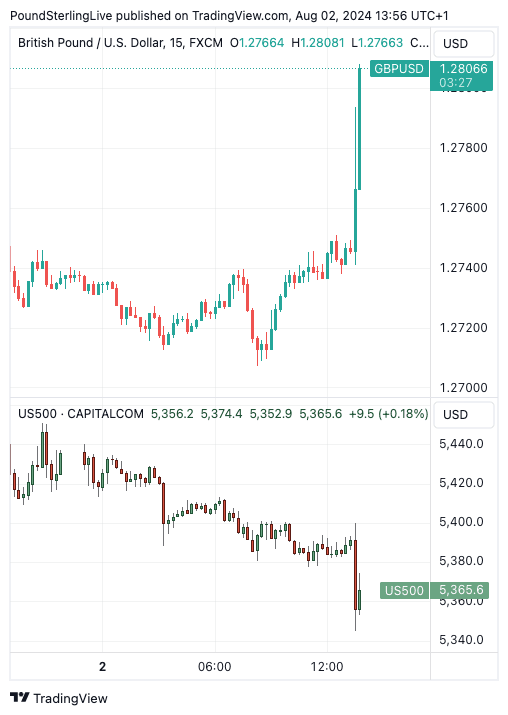GBP/USD Rate Rebounds on U.S. Job Panic, Talk of Emergency Fed Cut
- Written by: Gary Howes
-

Image © Adobe Images
The Pound to Dollar exchange rate rose and stocks tanked after a highly anticipated U.S. job report confirmed unemployment continues to rise as the economy slows.
Money markets moved to price in 100 basis points of interest rate cuts at the Federal Reserve in 2024 after the U.S. unemployment rate rose to 4.3% in July, and nonfarm payroll employment edged up by 114K, down from 179K in June and well below analyst expectations for 176K.
Economists think the Fed could go with an outsized 50 bp cut in September or even deliver an inter-meeting cut.
"The totality of today’s jobs report is leading markets to signal not one but two concerns: a growth scare, and worries about a Federal Reserve policy mistake," says economist Mohamed A. El-Erian, former CEO of Pimco and current advisor to Allianz and Gramercy.

Above: GBP/USD (top) and the S&P 500 (lower panel) show the Dollar is not benefiting from U.S.-centric sentiment deterioration.
The Dollar was broadly weaker in response: the Pound to Dollar rate recovered earlier losses and is a third of a per cent up on the day at 1.2790. The Euro-Dollar is a chunky 0.85% higher at 1.0881 and Dollar-Yen is 1.34% lower at 147.35.
The odds of a reactionary 50bp cut at the September meeting have risen further, with market pricing showing rising beyond a 30% probability.
Private-sector firms added 97K jobs in July, the weakest since March 2023, and the three-month average private-sector payroll growth (142K edged down to the lowest level since January 2021.
"Dear Fed: As some of us have been saying for a while, you’re well behind the curve. Inflation has been beaten; labour market weakening fast. Cut, cut, cut," says Nobel laureate economist Paul Krugman.
Stock markets are sharply lower on these data as investors fret the Fed has let it too late to cut rates. This is, in turn, weighing on the Pound.
Furthermore, a surge in rate cut expectations at the Federal Reserve tends to result in a similar outcome for Bank of England expectations. This helps explain why the Pound is lower against a host of other currencies.
Images: @NickTimiraos
Emergency Rate Cut?
"The financial markets are nervous. The question of whether a recession might occur in the USA after all is being raised," says Thomas Gitzel, Chief Economist at VP Bank.
He explains that job creation remains at a comparatively robust level, although job creation is no longer on a par with previous months, and there are clear signs of a slowdown in the U.S. labour market.
Average hourly earnings rose 0.2% m/m in July, which pulls the annual growth rate down to 3.6% and suggests the labour market is a fading inflationary threat.
"In short, all this makes a September interest rate seem certain and raises the possibility of both a larger 50 bp cut or even an inter-meeting cut," says Stephen Brown, Deputy Chief North America Economist at Capital Economics.
Nick Timiraos, Chief economics correspondent at The Wall Street Journal, points out that at their June meeting, the unemployment rate in front of Fed officials was 4.0%.
Only 3 of 19 projected an unemployment rate ending Q4 above 4.1% under their base case outlook (which assumed 1-2 cuts this year). None had it above 4.3% in 2025-26.
In short, the labour is materially weaker than policymakers were expecting.
Steven Blitz, an economist at TS Lombard, says the Fed has a lot of room to cut; "the topline is that next up is whether a more than 25BP cut is in the offing for September, or even an inter-meeting cut in the funds rate."
📈 Q2 Investment Bank Forecasts for GBP vs. USD. See the Median, Highest and Lowest Targets for the Coming Months. Request Now.
At the July 31 FOMC meeting, Federal Reserve policymakers effectively committed to cutting interest rates in September.
"A reduction in our policy rate could be on the table as soon as the next meeting in September," said Federal Reserve Chair Jerome Powell at Wednesday's policy update.
He cited concerns that the labour market was weakening as a justification for cutting before headline inflation had fallen back to 2.0% on a sustained basis.
The market is signalling the Fed might be a bit late to the party, and some catch-up might now be needed.
This can weigh on the Dollar going forward.
"We reiterate our core view that the US Dollar, as well as both short-term interest rates and long-term bond yields should start to soften more meaningfully across 3Q, once the Fed embarks on its rate cutting cycle in September," says Peter Chia, Senior FX Strategist at UOB.
"Our updated forecasts see stronger upside for EUR/USD and GBP/USD to 1.15 and 1.36 respectively by 2Q25," says Chia.

